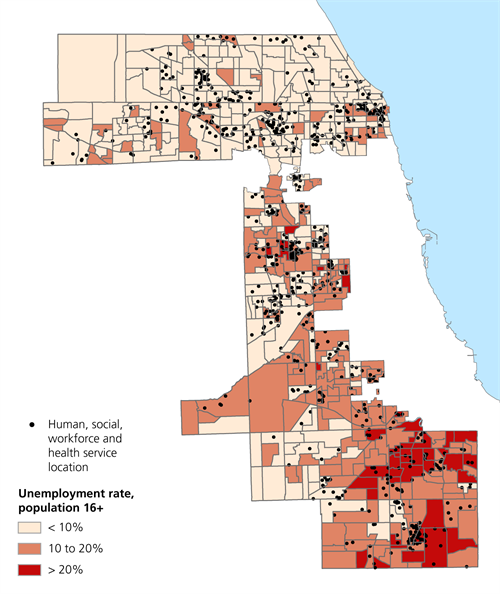
Flickr user Zachary Korb (CC)
When we think of poverty, we often think of disinvestment in the urban core. However, poverty is increasingly a suburban challenge as well.
When you think of poverty, do you think of the suburbs? Increasingly, that’s where poverty is heading. The Brookings Institution has done phenomenal work highlighting how poverty has moved to the suburbs and the need for local, regional and federal actors to pay attention to this growing trend. Their Confronting Suburban Poverty in America initiative is correct to emphasize that the needs and challenges facing the poor in the suburbs are distinct and different from those of the urban poor.
The challenges facing the poor in the suburbs are distinct from those of the urban poor.
The Metropolitan Planning Council (MPC) has a long history of working in the suburbs on housing, transportation and land-use issues, and we set out to better understand the relationship between poverty, income, unemployment and where human, social, workforce and health services are located. Is there a mismatch between where poor suburban residents live and where they can access, for example, the job training they may need for 21st century jobs? Is there a mismatch between where new immigrants are moving and where the services they need are located? The spatial mismatch has been top of mind for us.
Our initial analysis shows the suburban communities with the highest unemployment and poverty rates are not those communities with services to address these challenges. In suburban Cook County, only 43 percent of census tracts with high poverty rates (more than 20 percent) had human, social, workforce and health services.
Data about organizations and services came from a range of sources, including, but not limited to, the Cook County Sheriff’s Social Service Connector, which includes a directory of organizations providing clothing, counseling, education, emergency food and shelter, employment training, financial assistance, housing, legal, mental health and transportation services.
Mismatch between the location of social, human, health and unemployment services and where poverty is located

If we take a look at unemployment, we see a similar trend. In suburban Cook County, only 33 percent of census tracts with unemployment rates above 10 percent contained these human, social, workforce and health services. Granted, people do not just live, work, play, go to school and access services in the same census tract, but research shows that low-income households disproportionately use public transit to get around. Not only that, but they commute long hours to jobs that are increasingly far from the homes they can afford. Adding length to an already long commute increases the importance of easily accessible services in both urban and suburban locations.
Mismatch between the location of social, human, health and unemployment services and where unemployment is located

Employment, health, human and social services are critical to providing poor, suburban families with the resources to get back on their feet and become productive, employed residents. Having access to these services is not only beneficial for the individual but supports the Chicago region’s economy. According to the Center for American Progress, child poverty alone is estimated to cost the U.S. economy more than $500 billion annually in increased health costs, higher criminal justice expenditures and lost productivity. The Chicago region as a whole is suffering from our high poverty rates and we need better solutions for ensuring services reach the people who need them most in the most efficient way possible.
Child poverty alone is estimated to cost the U.S. economy more than $500 billion annually.
In light of these trends, local jurisdictions are looking for new ways to plan for and deploy related programming. For example, Cook County’s Planning for Progress five-year strategic plan, developed with support from the Chicago Metropolitan Agency for Planning Local Technical Assistance program, focuses on economic development, affordable housing and community development. MPC is excited that this plan recognizes these access challenges and sets forth fresh thinking about how to foster social service funding collaboration in suburban Cook County, amongst other key ideas. We look forward to partnering with the County to streamline through the creation of a 311 system and to target anti-poverty resources to the people and communities with the greatest needs.
In researching anti-poverty services, we faced significant challenges understanding the landscape of organizations working across suburban Cook County. We cobbled together the organizational data used in this analysis from the Sheriff’s Social Service Connect, Cook County Townships and a range of partners, such as the Alliance to End Homelessness in Suburban Cook County. Not only does a lack of data to analyze and target funding regionally impact the families that need these services, but it indicates we are likely not spending our limited resources effectively.
Similarly, as the Confronting Suburban Poverty initiative highlights, philanthropy has not yet adapted to the shifting geography of poverty and suburban needs. In 2007, philanthropy in the Chicago region distributed $39.5 million to the city and only $1.2 million in the suburbs, a 33:1 ratio! Building a stronger, healthier Chicagoland will require innovative, effective solutions from both the private and public sectors. No one entity can address Chicago’s growing poverty; a joint and collaborative approach between the private and public sectors could take us much further.
Looking beyond the suburban poverty and services mismatch, MPC has been researching how the fragmentation of government funding, whether that be Community Development Block Grants or funding to help communities manage stormwater impacts the region. In the community development sphere alone, there are dozens of sources, but no regional plan to effectively target those funds for the highest impact, to match other funding and plans or leverage other investments. To create strong communities and a strong region, we need to consider a regional solution for allocating precious public funds.